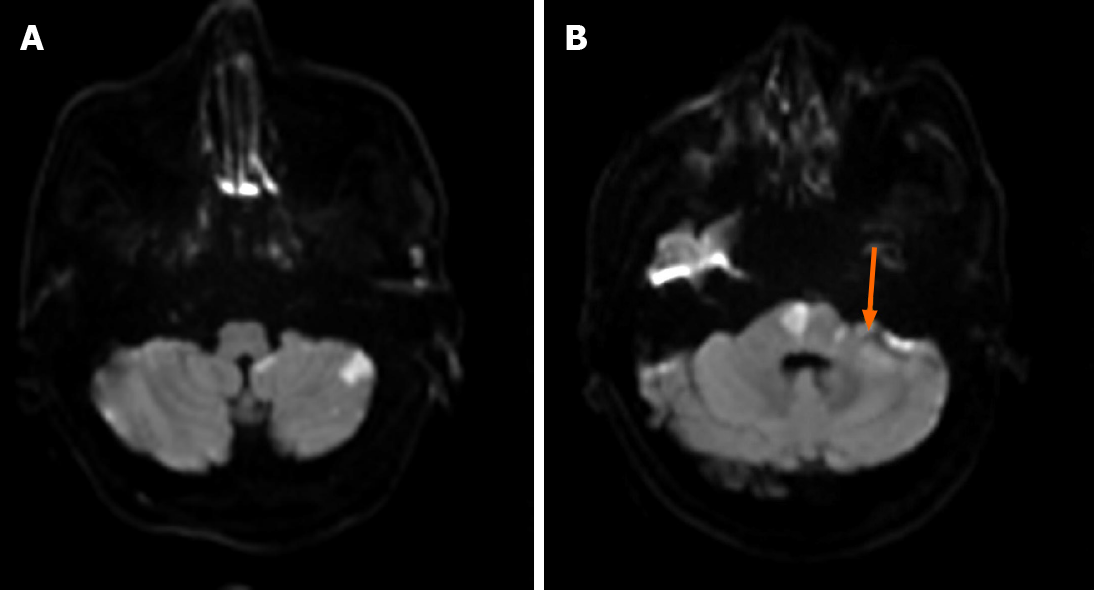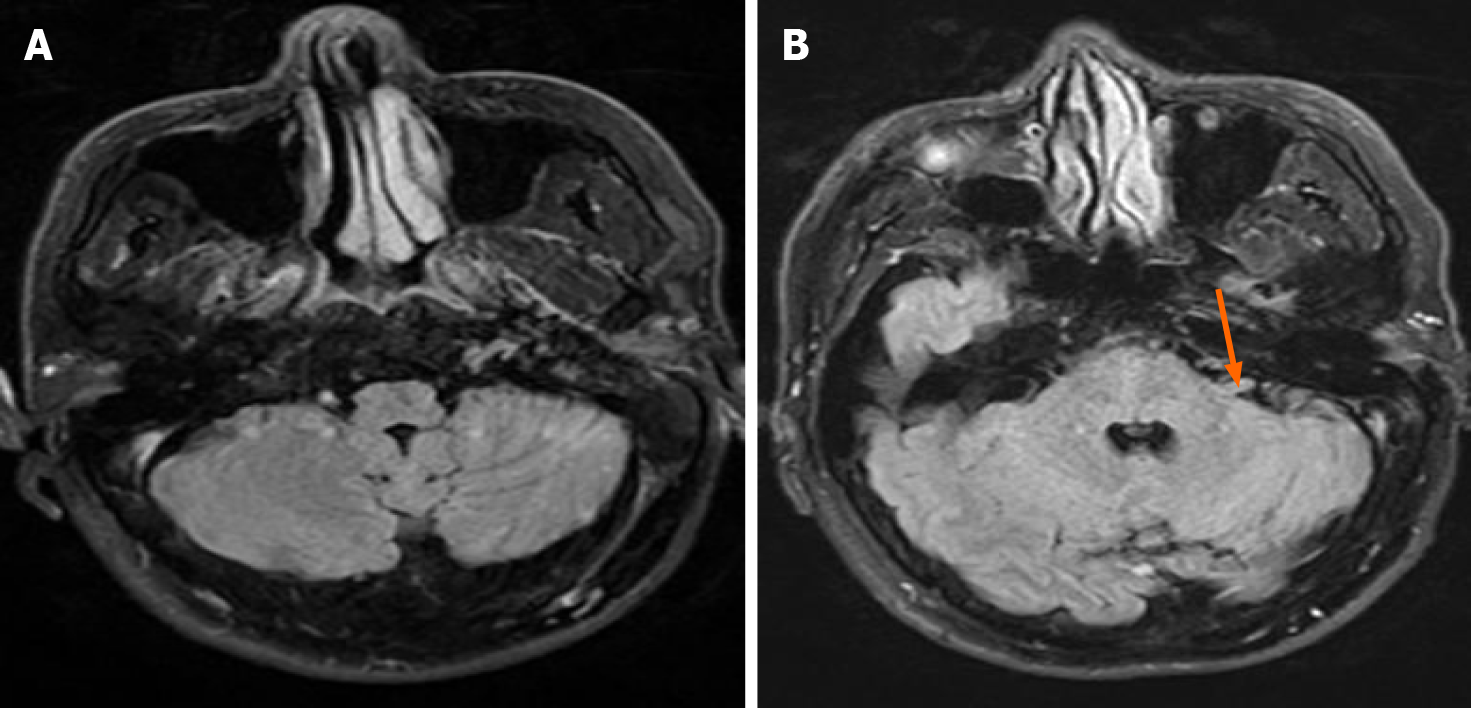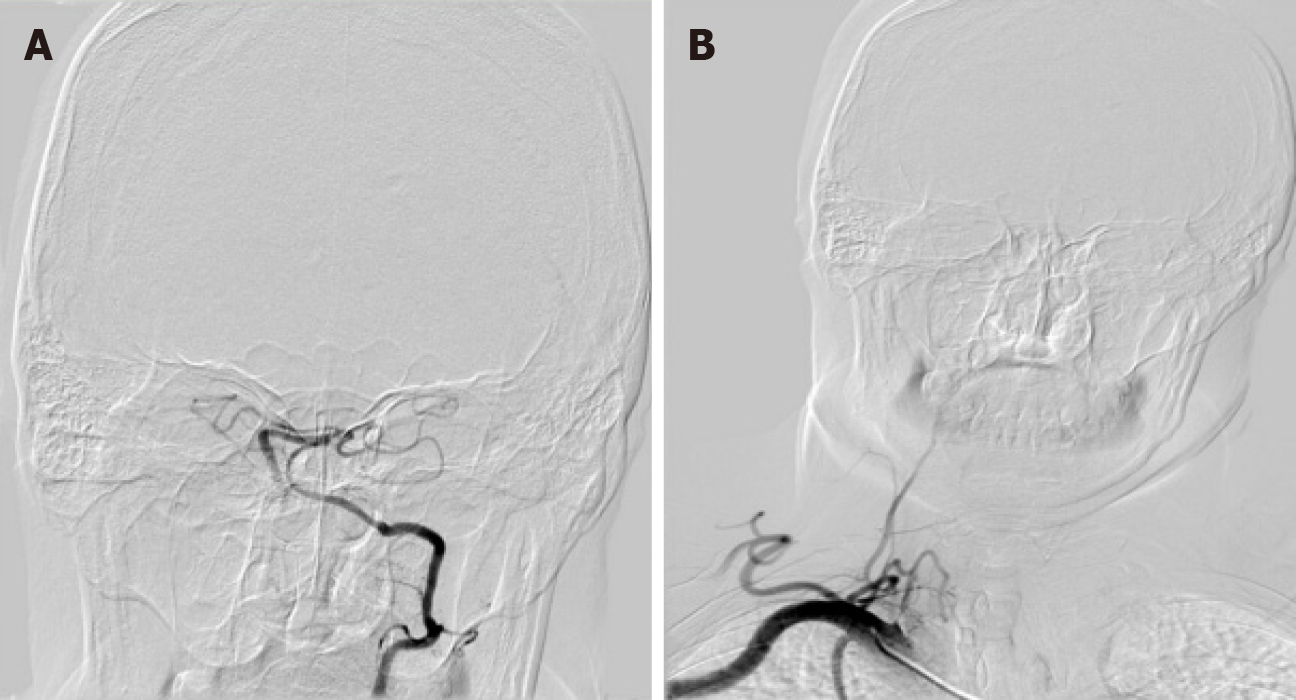Published online Apr 16, 2021. doi: 10.12998/wjcc.v9.i11.2519
Peer-review started: October 2, 2020
First decision: December 24, 2020
Revised: December 30, 2020
Accepted: February 11, 2021
Article in press: February 11, 2021
Published online: April 16, 2021
Processing time: 166 Days and 8.8 Hours
Sudden hearing loss (SHL) is associated with serious systematic conditions such as neoplasms, vascular events, autoimmune diseases, infections, and iatrogenic injury. Some authors report that SHL can be an early warning sign of impending vertebrobasilar ischemic stroke. It is important to distinguish stroke from benign disease.
A 48-year-old male patient presented with SHL and vertigo as first symptoms. Diffusion-weighted imaging revealed high signal intensity in the left posterior inferior cerebellar artery territory of the cerebellar hemisphere and high signal intensity in the right pons and bridge cerebellar arm, confirming that the patient had cerebral infarction. Treatment with antiplatelet drugs, steroid anti-inflammatory drugs, and neurotrophic nerve therapy promoted blood circulation and removed blood stasis, and the symptoms of the patient were significantly improved.
SHL and vertigo could be the initial symptoms of vertebrobasilar ischemic stroke.
Core Tip: We report a 48-year-old male patient who was confirmed to have cerebral infarction with sudden hearing loss and vertigo as initial presenting symptoms. Our case suggests that if a patient with vascular risk factors initially present with SHL and vertigo before additional signs of brainstem or cerebellar infarction appear, doctors should consider the possibility of symptoms of posterior circulation infarction. For stroke patients, timely diagnosis and treatment are needed.
- Citation: Wang XL, Sun M, Wang XP. Cerebellar artery infarction with sudden hearing loss and vertigo as initial symptoms: A case report. World J Clin Cases 2021; 9(11): 2519-2523
- URL: https://www.wjgnet.com/2307-8960/full/v9/i11/2519.htm
- DOI: https://dx.doi.org/10.12998/wjcc.v9.i11.2519
Sudden hearing loss (SHL) is defined as acute sensorineural hearing loss of more than 30 dB over three or more consecutive frequencies in a pure-tone audiometry test[1]. Various causes, such as infection, vascular events, coagulation disorders, neoplasms, and demyelinating disease, are related to SHL; however, in most cases, the cause is idiopathic[2]. Among vascular factors, infarction caused by thrombosis or embolism of the anterior inferior cerebellar artery (AICA) is the main cause. Only 1% of patients experience SHL because of a non-AICA territory vertebrobasilar ischemic stroke[3]. It has been suggested, therefore, that new hearing loss in the context of acute vertigo might be an important stroke predictor[4]. However, the underlying cause of the SHL and vertigo is controversial. Although many clinicians take it as a benign disease, such as Menière’s disease or labyrinthitis, we should distinguish it from stroke, especially infarction. To clarify the issue, we report a patient who developed unilateral SHL and vertigo as initial symptoms before simultaneous anterior inferior and posterior inferior cerebellar artery infarction.
A 48-year-old male patient was admitted to our emergency department with acute left hearing loss accompanied by spontaneous vertigo, nausea, and vomiting that occurred suddenly when he stood up, without other accompanying neurological symptoms.
Intracranial hemorrhage was excluded by head computed tomography. Therefore, we considered the patient had cerebral infarction, and he was given aspirin and statins. The next day, the patient had dysarthria, left facial palsy, left limb weakness, and ataxia but no nystagmus or sensory loss. He was then sent to the stroke unit for further examination and treatment.
He was found to have hypertension 1 year ago but did not receive proper medical treatment.
The patient had a long history of heavy smoking but no history of hearing impairment, head trauma, meningitis, autoimmune diseases, or taking any ototoxic drugs.
On admission, his vital signs included blood pressure 170/80 mmHg, pulse rate 82 bpm, respiration rate 19/min, and body temperature 36.6 °C. The left side pathological signs were positive by physical examination. Intracranial hemorrhage was excluded by head computed tomography. Therefore, we considered the patient had cerebral infarction, and he was given aspirin and statins. The next day, the patient had dysarthria, left facial palsy, left limb weakness, and ataxia but no nystagmus or sensory loss. No abnormality was found in the external auditory canal and tympanic membrane. Weber and Rinne tests demonstrated a sensorineural hearing defect on the left side. Unfortunately, there was no pure tone audiometry.
The results of whole blood count, serum electrolytes, liver function tests, urea nitrogen, creatinine, and C-reactive protein were normal. He was sent to the neurology ward for stroke treatment.
Diffusion-weighted imaging (DWI) revealed a high-signal intensity in the left posterior inferior cerebellar artery (PICA) territory of the cerebellar hemisphere and in the right pons and left bridge cerebellar arm (Figure 1). The yellow and thick arrow indicates that the left auditory nerve was thickened and slightly higher on T2 fluid-attenuated inversion recovery images and high signal on DWI, suggesting swelling of the auditory nerve (Figure 2). Cerebral angiography showed that the left vertebral artery supplied blood to the PICA but no development of the AICA. There was linear stenosis of the right vertebral artery and no development of the intracranial artery (Figure 3).
According to the clinical features and radiological findings, the patient was diagnosed with cerebral infarction that was supplied in the territory of the AICA and PICA.
When we considered that the patient had cerebral infarction, aspirin and statins were used immediately. After 10 d of further treatment in the stroke unit, the patient recovered and was discharged.
The patient was followed for at least 3 mo after the onset of SHL due to posterior circulation ischemic stroke and showed complete hearing recovery.
SHL has traditionally been considered to be a neglected and underestimated symptom of stroke. However, because the blood supply to the auditory system originates from the posterior circulation, stroke in the distribution of the posterior circulation can present with SHL and/or tinnitus[5]. In this case, the late occurrence of facial palsy and dysarthria following SHL and vertigo was sufficient to alarm the physician to the possibility of a vascular incident. Fortunately, after careful examination, we considered the patient had cerebral infarction, and he was given aspirin and statins. Magnetic resonance imaging plays an important role in the diagnosis of cerebral infarction, especially in auditory vestibular nerve infarction. In this patient, thin-section DWI allowed prompt and early diagnosis, which revealed a high signal intensity in the left AICA and PICA territories. The left auditory nerve was thickened and slightly higher on T2 fluid-attenuated inversion recovery images and high signal on DWI, suggesting swelling and infarction of auditory nerve.
To our knowledge, the internal auditory artery (IAA) is a main feeder to the inner ear and usually originates from the AICA or less frequently from the PICA or basilar artery[6]. The IAA divides into two main branches: The common cochlear artery and the anterior vestibular artery. The common cochlear artery further branches into the main cochlear artery and the vestibulocochlear artery; the latter forming the posterior vestibular artery and the cochlear ramus[7]. The posterior vestibular artery is the source of blood supply to the inferior part of the saccule and the ampulla of the posterior semicircular canal[8]. Diseases involving the IAA usually affect both the cochlea and the vestibular labyrinth, resulting in audio vestibulopathy. Thus, differentiating acute infarction from acute labyrinthitis is important to prevent the spread of infarction. Patients with AICA infarction may present with both central and peripheral vestibulopathies[9]. However, audiovestibular loss due to non-AICA territory posterior circulation infarction is commonly associated with cerebellar infarction in the territory of the PICA.
Our patient had SHL and vertigo as initial presenting symptoms, which could be predictors of cerebral infarction. Cerebral angiography showed that the left vertebral artery supplied blood to the PICA but no development of AICA, which could explain the cerebral infarction in the territories of the left AICA and PICA. We also saw that there was linear stenosis of the right vertebral artery and no development of the intracranial artery, which resulted in infarction of the right pons. This finding suggested that physicians may also consider the possibility of an impending symptom of AICA and/or PICA infarction in patients with vascular risk factors and persistent vertigo, especially along with SHL, before additional brainstem or cerebellar symptoms appear. A recent study[10] on the long-term outcome of SHL with a vascular cause reported that approximately 65% of the patients who were followed for at least 1 year after the onset of SHL due to posterior circulation ischemic stroke (mainly AICA territory cerebellar infarction) showed partial or complete hearing recovery. Similarly, our patient’s left ear hearing loss was significantly improved after standardized treatment in the stroke unit.
Unfortunately, there was no pure tone audiometry in our patient. However, this did not affect our judgment of the disease. Clinicians should be aware of the possibility that SHL and vertigo may portend stroke, not just benign disease.
This case demonstrated that SHL and vertigo could be initial symptoms of vertebrobasilar ischemic stroke. When a physician encounters a patient with SHL and vertigo, it is important to consider whether it is of central or peripheral origin. Our case suggests that if a patient with vascular risk factors initially presents with SHL and vertigo before additional signs of brainstem or cerebellar infarction, physicians should consider the possibility of posterior circulation infarction. For stroke patients, timely diagnosis and treatment are needed.
Manuscript source: Unsolicited manuscript
Specialty type: Medicine, research and experimental
Country/Territory of origin: China
Peer-review report’s scientific quality classification
Grade A (Excellent): 0
Grade B (Very good): 0
Grade C (Good): C
Grade D (Fair): 0
Grade E (Poor): 0
P-Reviewer: Cho SY S-Editor: Fan JR L-Editor: Filipodia P-Editor: Yuan YY
| 2. | Schreiber BE, Agrup C, Haskard DO, Luxon LM. Sudden sensorineural hearing loss. Lancet. 2010;375:1203-1211. [RCA] [PubMed] [DOI] [Full Text] [Cited by in Crossref: 319] [Cited by in RCA: 352] [Article Influence: 23.5] [Reference Citation Analysis (0)] |
| 3. | Lee H. Sudden deafness related to posterior circulation infarction in the territory of the nonanterior inferior cerebellar artery: frequency, origin, and vascular topographical pattern. Eur Neurol. 2008;59:302-306. [RCA] [PubMed] [DOI] [Full Text] [Cited by in Crossref: 28] [Cited by in RCA: 30] [Article Influence: 1.8] [Reference Citation Analysis (0)] |
| 4. | Newman-Toker DE, Kerber KA, Hsieh YH, Pula JH, Omron R, Saber Tehrani AS, Mantokoudis G, Hanley DF, Zee DS, Kattah JC. HINTS outperforms ABCD2 to screen for stroke in acute continuous vertigo and dizziness. Acad Emerg Med. 2013;20:986-996. [RCA] [PubMed] [DOI] [Full Text] [Cited by in Crossref: 195] [Cited by in RCA: 250] [Article Influence: 20.8] [Reference Citation Analysis (0)] |
| 5. | Lee H, Sohn SI, Jung DK, Cho YW, Lim JG, Yi SD, Lee SR, Sohn CH, Baloh RW. Sudden deafness and anterior inferior cerebellar artery infarction. Stroke. 2002;33:2807-2812. [RCA] [PubMed] [DOI] [Full Text] [Cited by in Crossref: 132] [Cited by in RCA: 127] [Article Influence: 5.5] [Reference Citation Analysis (0)] |
| 6. | Kim JH, Roh KJ, Suh SH, Lee KY. Improvement of sudden bilateral hearing loss after vertebral artery stenting. J Neurointerv Surg. 2016;8:e12. [RCA] [PubMed] [DOI] [Full Text] [Cited by in Crossref: 6] [Cited by in RCA: 6] [Article Influence: 0.6] [Reference Citation Analysis (0)] |
| 7. | Kim JS, Lee H. Inner ear dysfunction due to vertebrobasilar ischemic stroke. Semin Neurol. 2009;29:534-540. [RCA] [PubMed] [DOI] [Full Text] [Cited by in Crossref: 43] [Cited by in RCA: 54] [Article Influence: 3.4] [Reference Citation Analysis (0)] |
| 8. | Mazzoni A. The vascular anatomy of the vestibular labyrinth in man. Acta Otolaryngol Suppl. 1990;472:1-83. [RCA] [PubMed] [DOI] [Full Text] [Cited by in Crossref: 50] [Cited by in RCA: 55] [Article Influence: 1.6] [Reference Citation Analysis (0)] |
| 9. | Lee H, Kim JS, Chung EJ, Yi HA, Chung IS, Lee SR, Shin JY. Infarction in the territory of anterior inferior cerebellar artery: spectrum of audiovestibular loss. Stroke. 2009;40:3745-3751. [RCA] [PubMed] [DOI] [Full Text] [Cited by in Crossref: 124] [Cited by in RCA: 122] [Article Influence: 7.6] [Reference Citation Analysis (0)] |
| 10. | Kim HA, Lee BC, Hong JH, Yeo CK, Yi HA, Lee H. Long-term prognosis for hearing recovery in stroke patients presenting vertigo and acute hearing loss. J Neurol Sci. 2014;339:176-182. [RCA] [PubMed] [DOI] [Full Text] [Cited by in Crossref: 10] [Cited by in RCA: 10] [Article Influence: 0.9] [Reference Citation Analysis (0)] |











